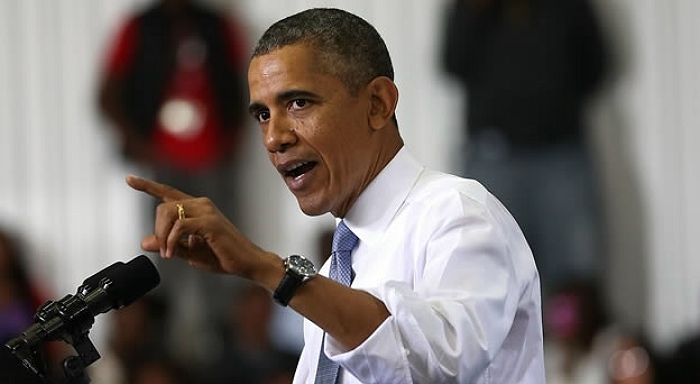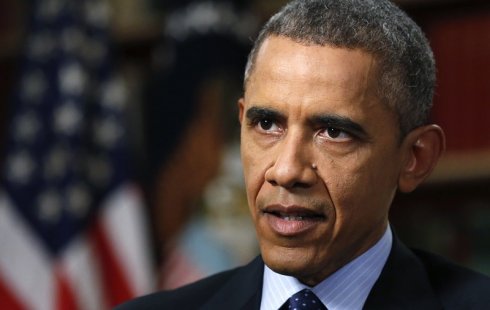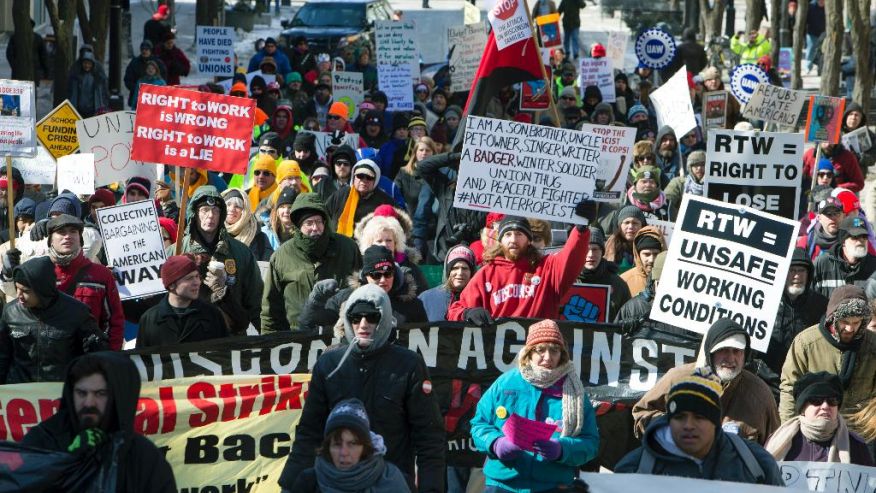USA
Unified Health Care … For Business
14/02/2014

During the first days of 2014, Obamacare was put into effect, the hard-promoted health care reform, pushed by US President Barack Obama since his first presidential campaign. Beyond its difficulties in implementation something is certain: the reform was designed to the measure of the big corporations.
It’s well-known that the USA has one of the world’s worst health systems: it’s the most expensive per capita and provides poor-quality service with low coverage [1] [2]. We should recall that the state does not provide a system of free health care. The uninsured, unless they are poor enough to qualify for Medicaid, have to pay for every procedure in a clinic, public hospital (13% of establishments) or private hospital. Such essential services as childbirth or fitness-for-duty exams have costs which customarily climb to thousands of dollars. So debts incurred by a family for accident or illness of one of their members is the main cause of bankruptcy in the USA [3]. Such is the form that the complete subordination of the health-care system to the interests of the big corporations acquires in the heart of the world capitalist imperialism, the subordination of the right to health to the rights of private property and capitalist profit.
To this end, the US capitalist class, as well as pulling the strings of Capitol Hill and the White House, counts on the complicity of the trade union bureaucracy, which goes about systematically surrendering historic gains in health care. The most recent example is the case of the Boeing workers in the Puget Sound/Seattle region, who voted against cuts in health benefits and pensions, but later the union’s national leadership (IAM) made a move to vote again, and this time the vote for accepting the new contract with Boeing won for a slight difference [4].
During the presidential campaign, Obama made health care reform one of his main slogans. But then the option of setting up a universal health care system financed by the state was off the table. The model used by the Obama administration is to be found in the health care reform put in place a few years before by Republican Mitt Romney when he was governor of the state of Massachusetts, and written by the reactionary Heritage Foundation think tank.
What’s the reform about?
The health care reform has two pillars: one, which gives it a progressive aspect, is the expansion of the Medicaid program, the health plan for people of very meager resources paid for by the government. Historically, Medicaid was administered with latitude by state governors, with relatively lax federal oversight. This explains the wide difference in requirements and benefits among the various states. For example, in 16 states the income level in order to be included in the program is less than 50% of the federal poverty line, while in others the coverage is greater (on average, the limit is 61% of the poverty line). Thus the program doesn’t reach as far as including half of poor adults.
The expansion of Medicaid included in the reform consists of raising the income limit to 138% of the federal poverty line uniformly in all states. That is, from January, it should cover adults who earn less than US $15,856 annually, or families of four who make less than US$32,499. The federal government will pay 100% of costs due to the expansion from 2014 to 2016. From then on, they’ll pay at least 90% till 2022. However, on June 2012, the Supreme Court ruled that it was in the states’ power to decide whether to accept the expansion of Medicaid or not. Till now, only half have done so. In this way, the duel between Republicans and Democrats plays out through the blocking of Medicaid expansion in all the states with Republican governors or Republican-led legislatures. An obvious problem which neither of the parties raises is that a broadening of beneficiaries further weigh down a health care network which is already overloaded, as expressed by delays in attention and the rejection of Medicaid patients by hospitals and doctors [5].
The health care reform’s corporate pillar is the “individual mandate.” This provision makes it mandatory for all US citizens to buy health insurance, like it or not.
In 2012, there were 47 million individuals without health coverage, 40% of whom had incomes below the poverty line. Thanks to the “individual mandate,” an estimate of 25 million people will begin to pay for health insurance. In case they don’t, they’ll be fined up to US$695 annually [6]. So it’s evident who the prime beneficiaries of health care reform are: insurance companies, doctors and private clinics. This is no accident. Health sector corporations deploy a powerful lobby in Congress and the White House and are among the main contributors to Obama’s presidential campaign. In 2009 alone, the year before the passage of the health care reform law, the health care industry invested $273,000,000 in lobbying.
Subsiding the health insurance companies
In order to guarantee that workers with middle and low incomes will be able to pay for health insurance, the Federal government will pay subsidies on a sliding scale according to the income level of those who earn between 133% and 400% of the poverty line income. That way, workers in this income range will enjoy substantial government aid to confront the $328/month on average which they will pay for a plan which won’t cover their entire health care costs, if needed. However, a great proportion of plans include a deductible (which can climb to over $5000 annually in the worst case), that is, a cost-floor, that the patient will face before insurance intervenes to pay for the benefits.
An important proportion of the population is excluded from government subsidies, like undocumented immigrants. In addition, in states which reject the expansion of Medicaid, neither will those with incomes below 133% of the poverty line and above the limit imposed by the state to receive Medicaid be able to receive subsidies to pay for their health insurance: a phenomenon called the “Medicaid Gap.”
The “employer mandate” requires that every employer with more than 50 full-time employees must offer them health insurance. The risk that small or medium-size enterprises may decide to reduce their payroll or put some workers on reduced hours in order not to reach this number was used by the Republican right wing to attack the measure, claiming that “Obamacare is a job killer”. Giving in to the employers’ pressure, the Obama administration decided to postpone the imposition of this provision till 2015 [7], enough time to distort or nullify it before it could be implemented.
The public option, a legend
One of the progressive alternatives initially included in health care reform was the so-called “public option.” Individuals would have been able to choose a government-offered plan which would compete with private plans and would offer similar benefits, always through private actors, helping to keep private paln prices low. However, the Democrats early on abandoned every intention of implementing such an initiative on a national scale, despite the fact that polls showed that 72% of the population is in favor of the government offering health care service.
The truth about obamacare
So what’s the real motive propelling health care reform? Profits for those who run health insurance companies, the pharmaceutical industry and private clinics were unsustainable. [Again, don’t forget the multi-billion dollar “not-for-profit” hospital/health-care sector. Their profits are also unsustainable. Eric]. The US health care cost per-capita has increased since 1970 at a rate 2.4% higher than the GDP. Health insurance premiums for their part more than doubled between 2000 and 2010. He inevitable tendencies was toward reducing the number of customers and toward a constant increase in insurance costs. Obamacare killed two birds with one stone: by including individuals at low risk of illness – healthy young people who typically don’t buy health insurance – the cost per capita falls. Then the insurance companies can offer more economical plans to the rest. In exchange for the favor, the concesions which the insurers had to make were minor: accept patients with pre-existing conditions and not greatly increase the cost of insurance according to each patient’s risk. Further, insurers were required to spend at least 80% of what they collected for medical services: the ways of dodging this demand are many, from altering accounting figures, to moving funds to brother organizations, NGOs or phony foundations. At the same time, the reform permits Obama to pose as a progressive by offering an extension of health care coverage to the poorest layers, with the intention of containing the discontent of the millions submerged in an economic and social situation which has worsened since the crisis let loose in 2007/2008. The reform is a maneuver to decompress the social discontent which has grown sharper in recent years.
The prototype of the individual who decides not to spend for health insurance is a low-income young worker. With the health care reform, low-income workers, together with the federal government, subsidize private medical enterprises. The Medicaid expansion is no more than the hook to bring in the support, in some cases ingenuous, in most cases knowing, of the US center-left.
To sum up, the government subsidizes health insurers and at the same time makes the whole working class pay part of the costs through mandatory purchase of health care service. The health care industry’s interests (laboratories, private clinics and hospitals, drugstore chains, etc.) in contrast remain intact. This is the anti-worker and pro-capitalist character which the Obama administration is working hard to hide.
Obama’s bad year
Putting Obamacare into effect was marked by failures in the registration web site and by the shut-down of the federal government which outraged the the country for over 15 days, the immediate result of the Congressional dispute with the Republicans, but which laid bare once again the depth of the economic and financial crisis through which the world’s greatest power was going. Taking into account the pro-business character of the health care reform, how to understand the stubborn opposition of the congressional Republicans? The Republican Party has been going through a drawn-out crisis since Bush’s last presidential term. Due to the manipulation of electoral districts, the Republicans don’t fear being defeated by the Democrats [This is regional, mostly in the Midwest and especially the South. In some Northeast and Pacific-coast states, the Democrats benefit from electoral “redistricting. According to Eric]; they rather fear the factionalism in their own party. In the context of the rise of the Tea Party (the ultraconservative wing of the Republican Party), the spasmodic efforts to defund health care reform were the arena in which they measured their degree of intransigence, at the same time, as per their custom, working to commodify the health care system even more. At the center of the budget discussion during the government shutdown was the tax on medical device manufacturers, a highly profitable industry. The Republicans – and many Democrats, among them the progressive Elizabeth Warren – did not give in in their effort to eliminate the 2.3% tax applied to these products since 2013 and which to a large degree helped finance Obamacare’s costs.
The Democratic administration, for its part, didn’t hold back from unpopular measures through 2013. In November, they cut the food stamp program which benefits 48,000,000 United States residents (1 of every 7 citizens). The program had grown greatly due to the expansion instituted at the beginning of the Great Recession, in response to the increase in poverty and unemployment. In 2010 the Democratic caucus voted in a bloc for the planned cut-back of the expansion, which was finally carried out in November 2013. Unemployment insurance was the other program whose expansion served as a counter-cyclical stimulus against the shock of the economic crisis. At the end of the first day of 2014, however, the time limit to receive this benefit was cut back to the previous level of 29 weeks (It had been extended to 99 weeks.) This caused the ending of the subsidy to 1,300,000 people. [Technically speaking, the initiative for the cutbacks in food stamps and unemployment compensation came from the Republican Party. The Democratic Party publicly claimed to oppose most cutbacks. Their explanation for their votes in favor is that they could only get enough Republican votes to pass any federal budget at all if they agreed to some cutbacks, but less than the Republicans at first demanded. Further, the Democrats promised that they would immediately partially restore extended unemployment benefits. They have not. Eric]
The Republican majority in Congress has laid a trap for Obama’s efforts to pass progressive measures, no matter how lukewarm or superficial, at a time when both Congress and the President are going through an unprecedented fall in popularity. As shown by a recent Washington Post/ABC poll, in the past year Obama has lost support from his progressive base and from the African-American community, in large part due to a fact which the OWS movement publicized, and which, far from being resolved is continuing to get worse: social inequality is becoming more marked, and the profits of the wealthiest 1% are growing despite the crisis. This discontent does not mean greater support for the Republicans. But expresses itself through disillusionment in bipartisanship, and, in some cases, with the strengthening of independent or left options, as in the triumph of Kshama Sawant of Socialist Alternative in Seattle.
Among his desperate attempts to regain popularity, there are three themes which Obama will include in his speeches this year, but which he will be unable to resolve: the fight for a [minimum] wage above $15/hour throughout the territory of the USA, the costs of – and debts generated by–the higher education system, and immigration reform. However, neither Obama nor the bourgeois opposition can solve the problem of access to health care, unemployment, poverty and access to education which millions of people in the USA suffer. For that, it would be necessary to attack the interests of the capitalist companies, something which no bourgeois politician is disposed to do. Only the working classs will be able to respond to these problems, fighting together with the rest of the exploited so that all resources will belong to society as a whole.
Abortion and contraceptive methods
The treatment of abortion and methods of contraceptives merits its own paragraph. In response to the pressure exercised by ultraconservative groups, federal health care funds will not be able to be used to pay for a plan which pays for termination of pregnancy. Women of child-bearing age who seek such coverage will have to pay out of their own pockets and do without federal economic aid for it.
As of this writing, ultra-Catholic groups are pressing for exceptions for schools, hospitals and other non-profit organizations from the obligation to pay for health insurance for their employees which provides contraceptive methods. Various reactionary media organizations like Fox News and Forbes declare without cover the religious convictions of these institutions must prevail over their employees’ right to family planning.
NOTASADICIONALES
[1] Health Care Spending, en http://ucatlas.ucsc.edu/spend.php
[2] Squires D, “The U.S. Health System in Perspective: A Comparison of Twelve Industrialized Nations,” The Commonwealth Fund, July 2011
[3] Navarro, V. (2009). “What we mean by social determinants of health”, International Journal of Health Services, 39(3), 423-441.
[4] Levitt J, “Boeing Machinists Narrowly Approve End to Pensions”, Labor Notes, January 06, 2014
[5] Hellander, I., & Bhargavan, R. (2012). “Report from the United States: The US Health Crisis Deepens Amid Rising Inequality–A Review of Data”, 2011. International Journal of Health Services, 42(2), 161-175.
[6] Kaiser Family Foundation, “Health care costs: key information on health care costs and their impact”.
[7] Kliff S, “White House delays employer mandate requirement until 2015”, Washington Post, July 2 2013.


![Declaration of the Movimiento de los Trabajadores Socialistas [MTS] facing the brutal murder and disappearance of the normalistas students of Ayotzinapa](http://www.ft-ci.org/IMG/arton8590.jpg?1687978277)

















